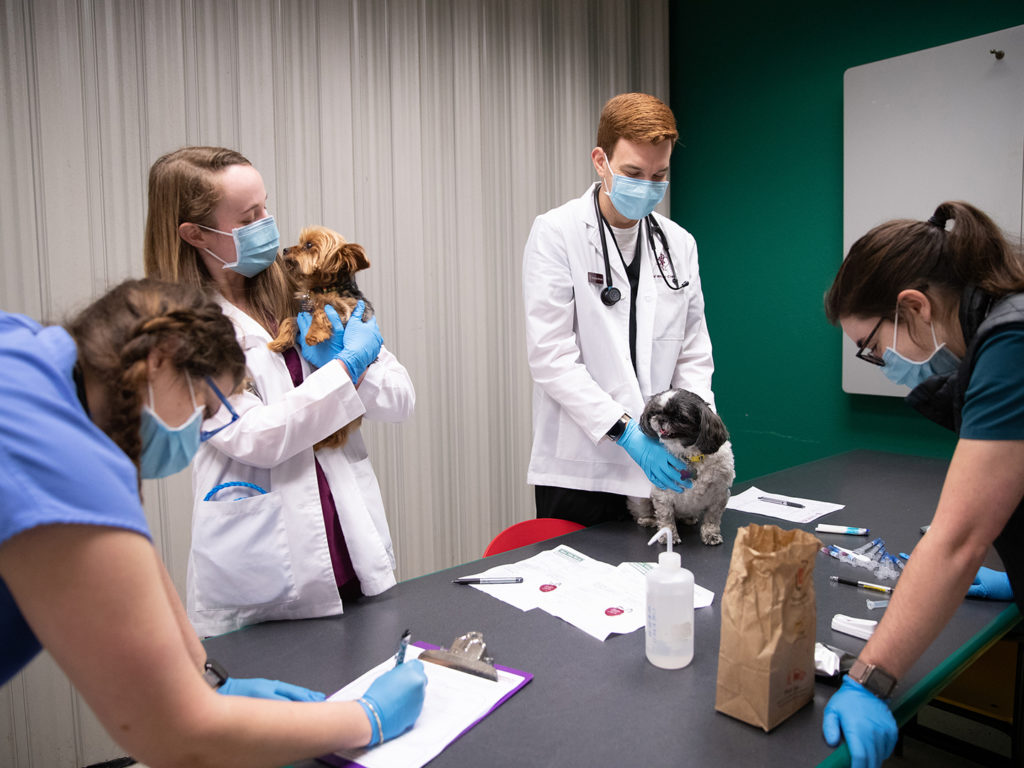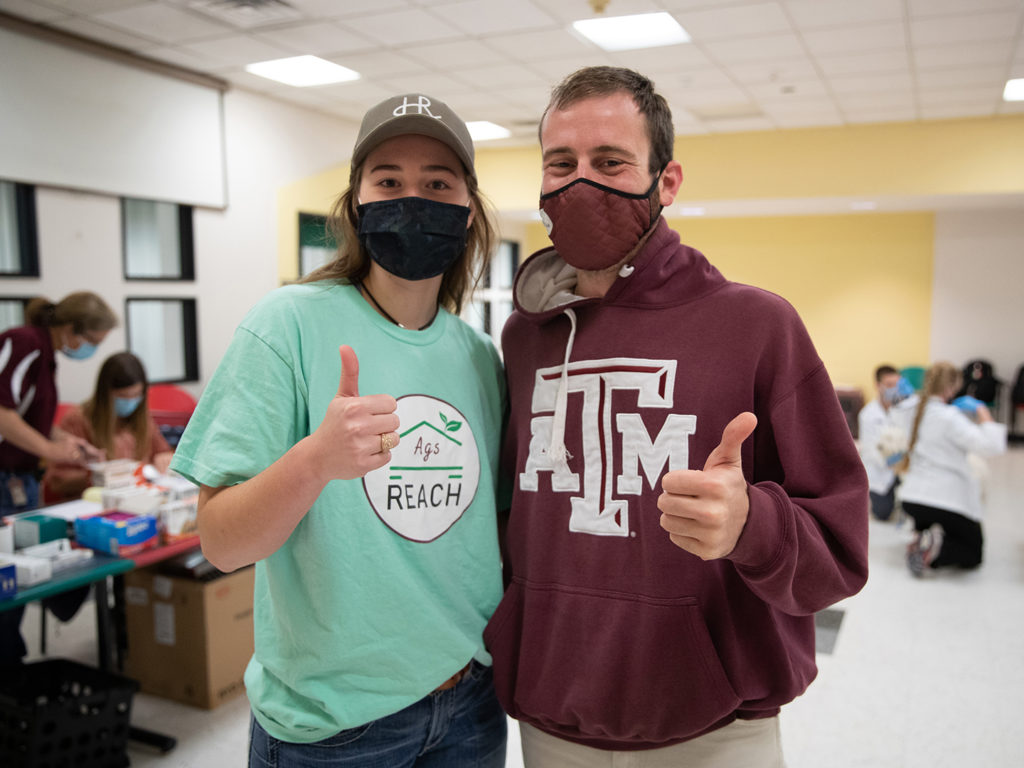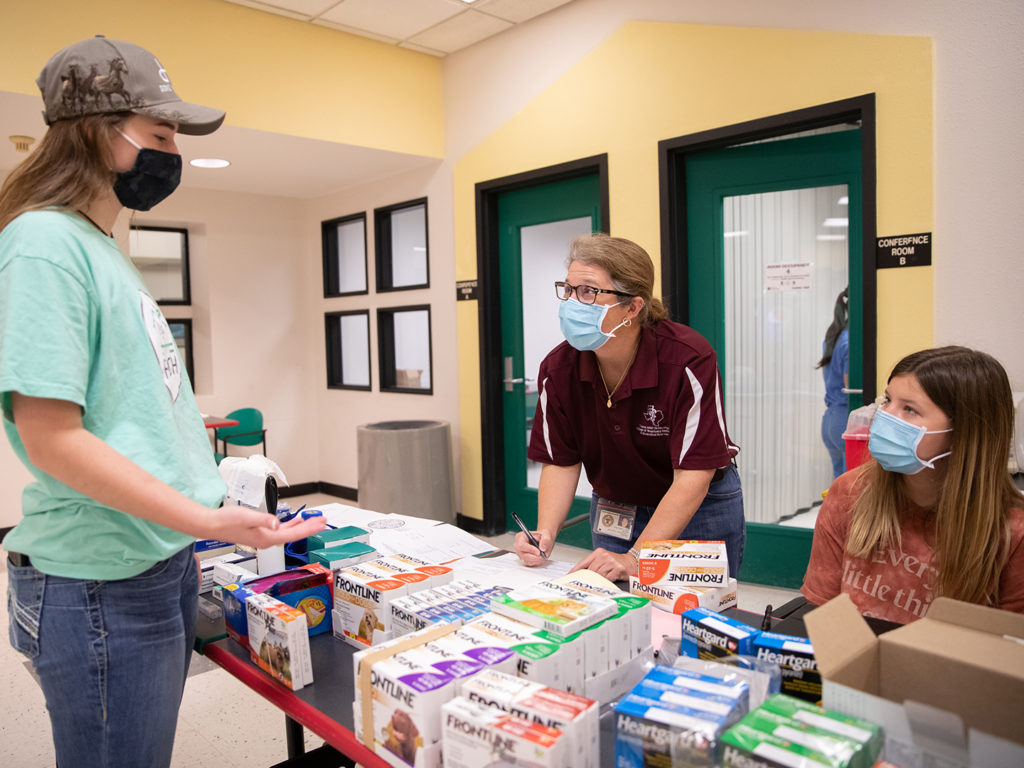Texas A&M Students Bring Veterinary Medicine To Underserved Members Of Campus Community
Story by Megan Myers, VMBS Communications

For as long as she can remember, recent biomedical sciences graduate Emma Bender ’22 has loved animals and desired to become a veterinarian. When she discovered a passion for community service as well, she decided to dedicate her career to serving both people and animals.
While volunteering at a service event for the Texas A&M student organization Ags REACH, she had an idea that would allow her to start achieving her goals while still a student.
Bender recalled that members of her local community had reduced access to veterinary care for their pets and came up with a way to make a difference.
“I was having a conversation about a health fair we were planning for our essential Aggies, when I started thinking it would be really cool if we could take care of their pets as well,” the Plano native said.
Her dream became a reality when the Texas A&M School of Veterinary Medicine & Biomedical Sciences (VMBS) and the REACH project of Bryan partnered to host the REACH Pet Health Fair for Texas A&M’s essential workers.
During the recurring event, service workers from the Texas A&M campus are invited to bring their pets to a free pet wellness clinic that offers physical examinations, heartworm and fecal tests, heartworm prevention, and vaccinations by VMBS veterinary students, under faculty supervision.
Serving People And Pets
The REACH (Respect Empowerment Aspiration Community Hope) Project is a nonprofit organization founded in 2017 by Texas A&M alumnus Max Gerall ’18 to support the university’s more than 3,000 contracted, third-party workers, including food service, custodial, grounds, and maintenance employees, many of whom face daily struggles.
REACH provides these community members with health, education, and housing resources, areas in which many of them feel gaps. The nonprofit regularly operates in partnership with Texas A&M-affiliated Ags REACH, which provides the manpower to help REACH achieve its goals.
Partnering with the VMBS, the REACH Pet Health Fair provides free services to the pets of essential workers who otherwise may not be able to access the same level of care.
One of the clients was Chanika Moses, a dietitian for Compass USA who works at Texas A&M, who brought her dog, Puppins, and cat, Noodles, for a checkup.
“It went very well and it was a great experience,” Moses said. “These pets are our support animals; my dog, especially, knows when we’re hurting, emotionally or physically, and she comes to snuggle with us. She tries to make us feel better in any way she can.
“They’re a very important part of our family and we try to take care of them as much as possible, but we want to do it at a low cost,” she said. “Going to the vet is very expensive, so this opportunity saved us a lot and we can redistribute that income toward things other than that dreaded vet bill.”
Moses plans to return for future pet health fairs and to other collaborations between REACH and the VMBS.
“It’s honestly amazing to see how many people we’re helping,” Bender said. “As I’ve been in contact with our essential Aggies, they are all just so grateful that we’re doing this for them. Seeing this unfold as something that I created is just incredible and, honestly, really hard to put into words.”
Finding Joy From Helping Others

Finding fulfillment in community service was something Bender first experienced in high school while participating in summer mission trips for her church.
“We went to Crossville, Tennessee, every summer to serve the underprivileged and put on a Vacation Bible School-type event for the children,” she said. “Being able to interact with those kids and see how much they loved what we did for them was honestly more fulfilling than probably anything else I could ever do.”
Besides helping others, veterinary medicine is one of her other greatest passions in life.
“I’ve always wanted to be a vet. Literally since before I can remember, that’s all I’ve ever wanted to do,” she said. “Through high school, all of my opportunities shadowing veterinarians, and working at vet clinics, I have not changed my mind.”
While the world-renowned VMBS was Bender’s main motivation for attending Texas A&M, she was also attracted to the university’s focus on selfless service.
“It’s amazing because there are just so many opportunities for students to get involved in the community,” she said.
Bender is already planning for a future that combines her loves for veterinary medicine and community service. She envisions a career in which she can use her skills in small animal medicine to support local animal shelters and community members in need.
An Opportunity To Give Back
For the VMBS, the pet health fair not only provides a way to give back to the community, but it also gives veterinary students a chance to practice everyday skills like performing exams, giving vaccines, and running diagnostic tests, under faculty supervision.
“I chose to participate because I love meeting different pet owners and, through conversing with them, coming to appreciate their unique human-animal bond,” said fourth-year veterinary student Rachael Barton, who volunteered at the health fair as a third-year.
“While some aspects of preventative care may be intuitive for us vet students, we should never assume that owners know and understand what prevention their pet needs,” she said. “That’s an area where we, as veterinary students, can help. Through outreach events such as this one, we can make preventative care much more accessible for our community.”
During the event, second- and third-year veterinary students greet clients, take their pets’ histories, determine if any specific health issues needed to be addressed, and then bring the animals inside; they then worked with a fourth-year veterinary student to do a full physical exam and administer vaccines.
“The pet health fair was a great opportunity for me to practice both my soft communication skills and my clinical skills, such as drawing blood and giving vaccinations,” Barton said. “Some of the fourth-year veterinary students gave me some great physical exam tips.”
That students work together practicing peer-to-peer education across different classes was another of the unique educational aspects of the event.
“Our fourth-year students were educating our third- and second-year students about what they were doing (during the pets’ physical exams), so it was an opportunity not only for them to provide service to their community but also to learn from each other in the process, which is how veterinary medicine often works,” said Dr. Karen Cornell, VMBS associate dean for Professional Programs.
“Veterinarians are a huge part of any community they’re within—they’re respected members and leaders,” Cornell said. “It’s so important that we maintain that and really own that responsibility and accountability. We want to train our students that that is part of who you are as a veterinarian.”
A Worthy Cause

The idea for the REACH Project first began when Gerall, who went on to become REACH’s founder and executive director, met Melissa Martinez, an on-campus dining hall cashier, as a freshman.
“It all started because of a really close relationship with Mrs. Melissa, a front desk cashier at Sbisa Dining Hall. We got so close that she became my ‘on-campus mom,’” Gerall said. “She’s a beautiful person who really opened my eyes to the invisible yet essential part of our community that’s all around us here on the A&M campus.
“As I met with and talked to more and more of these employees, I came to realize that I now have friends who are living in parallel universes; that knowledge changed the trajectory of my life,” he said. “Among my newest invisible friends there were homeless employees, families living in cheap motels, sick employees without access to affordable healthcare, and hundreds more dependent on neighbors for transportation to work.”
After graduating with a bachelor’s degree in communication, he decided to dedicate his career to giving back to those workers who spend each day supporting the university. Since then, he has gone on to meet and develop relationships with the 700 essential Aggies REACH supports.
“Being a Land Grant Institution, Texas A&M has access to vast intellectual and physical resources so that when combined with an incredibly passionate student body, the sky truly is the limit,” Gerall said. “For the vet school and their students to come together and support some of the most vulnerable members of our campus community speaks volumes about who they are and what they stand for and we are honored to have this partnership.”
REACH and the VMBS plan to continue holding the Pet Health Fairs each semester.
“The REACH Project is such a great program, and we are constantly looking, as all Aggies are, for selfless service opportunities,” Cornell said. “This was just a logical connection for us to be able to provide veterinary care to those folks’ pets. It’s an amazing group of people that we’re serving, a very deserving group of people, and we want to make sure that we provide them with equivalent service to what they provide us with every day.”
###
Note: This story originally appeared in the Summer 2022 edition of CVMBS Today.
For more information about the Texas A&M School of Veterinary Medicine & Biomedical Sciences, please visit our website at vetmed.tamu.edu or join us on Facebook, Instagram, and Twitter.
Contact Information: Jennifer Gauntt, Director of VMBS Communications, Texas A&M School of Veterinary Medicine & Biomedical Sciences; jgauntt@cvm.tamu.edu; 979-862-4216


